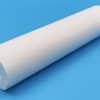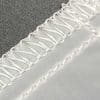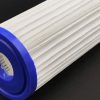3. Features and Benefits of Filtration Bags
Filtration bags are essential tools in numerous industrial processes, providing reliable solutions for liquid filtration. Understanding their features and benefits helps industries make informed decisions about their filtration needs. This section highlights the key attributes of filtration bags and their advantages in various applications.
3.1 High Filtration Efficiency
One of the primary features of filtration bags is their high filtration efficiency, which refers to the ability to effectively remove solid particles and contaminants from liquids.
- Particle Retention: Filtration bags are designed to capture a wide range of particles, from larger debris to fine particulates. The effectiveness of filtration is determined by the bag’s micron rating, which indicates the smallest particle size the bag can filter. For example, a 1-micron filter bag can trap bacteria and small contaminants, while a 25-micron bag is more suited for larger particulates.
- Multi-Layer Options: Many filtration bags offer multi-layer designs that enhance filtration capabilities. These bags consist of various materials that capture particles at different levels, improving overall dirt-holding capacity and efficiency.
3.2 Versatile Applications
Filtration bags are incredibly versatile, serving various industries and applications. Their adaptability makes them suitable for numerous uses:
- Water Treatment: In municipal and industrial water treatment, filtration bags help remove suspended solids, sediments, and contaminants, ensuring clean and safe water for consumption and use.
- Chemical Processing: Filtration bags are widely used to filter chemicals and solvents, ensuring that the final products meet purity standards and are free from unwanted particulates.
- Food and Beverage Production: In the food and beverage industry, filtration bags are crucial for maintaining hygiene and quality. They help filter out impurities in liquids, such as juices, oils, and beer, ensuring that the end product meets safety regulations.
- Pharmaceuticals: In pharmaceutical manufacturing, where product purity is paramount, filtration bags are used to ensure that drugs and other products are free from contaminants, thus meeting stringent regulatory requirements.
3.3 Eco-Friendly Options
As environmental concerns grow, many industries are seeking sustainable solutions. Filtration bags can contribute to eco-friendly practices in several ways:
- Reusable Bags: Some filtration bags are designed for multiple uses, reducing waste and lowering operational costs. When properly maintained and cleaned, these bags can serve extended periods, making them a sustainable choice.
- Recyclable Materials: Many manufacturers offer filtration bags made from recyclable materials, contributing to reduced environmental impact. Choosing recyclable options helps industries comply with sustainability goals and regulations.
- Biodegradable Options: Innovations in materials have led to the development of biodegradable filtration bags, which break down naturally over time, minimizing environmental pollution.
3.4 Cost-Effectiveness
Using filtration bags can lead to significant cost savings for businesses:
- Reduced Downtime: By efficiently removing contaminants, filtration bags help prevent equipment damage and reduce maintenance needs. This minimizes downtime for cleaning and repairs, ensuring smooth operations.
- Longer Equipment Lifespan: Protecting machinery from particulate damage can extend the lifespan of pumps, valves, and other components. This not only saves on replacement costs but also lowers overall operational expenses.
- Bulk Purchasing Options: Many suppliers offer bulk purchasing discounts, making it more economical for businesses to stock up on filtration bags and reduce per-unit costs.
3.5 Customization Flexibility
Filtration bags can be customized to suit specific operational requirements, enhancing their functionality and performance. Customization options may include:
- Size and Shape: Custom sizing ensures that filtration bags fit perfectly into existing filtration systems, maximizing their efficiency and effectiveness.
- Micron Ratings: Tailoring the micron rating allows businesses to select filtration bags that specifically address their needs, whether for fine or coarse filtration.
- Special Features: Options such as drawstring closures, anti-static properties, and reinforced seams can enhance usability and performance, catering to unique industry demands.
3.6 Ease of Use and Installation
Filtration bags are designed for straightforward installation and use, making them accessible for operators:
- Quick Replacement: Many filtration bags feature designs that allow for easy and quick replacement, reducing downtime during bag changes and enabling efficient workflows.
- Minimal Training Required: The intuitive design of filtration bags means that operators can quickly learn how to install and replace them, reducing the need for extensive training.
3.7 Compliance with Industry Standards
Many filtration bags are manufactured to meet specific industry standards, ensuring quality and safety:
- Regulatory Compliance: Using filtration bags that meet relevant certifications (e.g., ISO, FDA, NSF) helps businesses comply with industry regulations, reducing the risk of penalties and enhancing consumer trust.
- Quality Assurance: Filtration bags produced under strict quality control processes ensure that businesses receive reliable products that perform consistently over time.
4. Product Specifications
When selecting filtration bags for specific applications, understanding their product specifications is essential. This section outlines the key specifications of filtration bags, including dimensions, design variations, materials, and performance metrics. These specifications help businesses choose the right filtration solution for their operational needs.
4.1 Dimensions
Filtration bags come in various sizes and shapes to fit different filter housings and applications. Key dimensions to consider include:
- Diameter: Filtration bags can have different diameters, typically ranging from 4 inches to 30 inches or more. The diameter is crucial for ensuring a proper fit within the filter housing.
- Length: The length of filtration bags usually varies between 10 inches to 50 inches. Longer bags can provide increased surface area for filtration, enhancing dirt-holding capacity.
- Custom Sizes: Many manufacturers offer custom sizing options to accommodate specific filtration systems. Businesses can request filtration bags tailored to their unique requirements.
4.2 Design Variations
Filtration bags are available in various designs, each offering unique features and benefits:
- Standard Bags: These bags are simple in design and often made from single-layer filtration media. They are suitable for general filtration tasks.
- Multi-Layer Bags: Constructed with multiple layers of filtration media, these bags provide enhanced filtration capabilities, allowing for improved particle retention and longer service life.
- Drawstring Closure Bags: Featuring a drawstring mechanism, these bags can be tightened for a secure fit, making installation and removal easier.
- Snap Closure Bags: These bags come with snap closures for quick and convenient installation, ideal for processes requiring rapid bag changes.
- Customized Shapes: Businesses can order filtration bags in various shapes, such as cylindrical, rectangular, or square, depending on their filtration systems.
4.3 Materials
The choice of materials significantly affects the performance and durability of filtration bags. Common materials include:
- Polyester Felt: Known for its durability and high filtration efficiency, polyester felt is ideal for applications requiring fine particle removal.
- Nylon Mesh: This material offers excellent strength and flexibility, making it suitable for coarse filtration tasks. Nylon mesh bags are often reusable and easy to clean.
- Polypropylene: Lightweight and resistant to chemicals, polypropylene bags are commonly used in industrial applications where cost-effectiveness is essential.
- Polyethylene: Often used for disposable filtration bags, polyethylene is cost-effective and suitable for simple filtration tasks.
4.4 Micron Ratings
The micron rating indicates the size of particles that a filtration bag can effectively capture. Common ratings include:
- 1 Micron: Ideal for high-purity applications, capable of removing fine particulates, including bacteria.
- 5 Microns: Suitable for general filtration tasks, balancing efficiency and flow rate.
- 10 Microns: Effective for removing larger particles, often used in pre-filtration stages.
- 25 Microns and Above: Designed for coarse filtration tasks, allowing for higher flow rates and removal of larger debris.
Selecting the appropriate micron rating is critical for achieving desired filtration results and protecting downstream equipment.
4.5 Performance Metrics
When evaluating filtration bags, several performance metrics should be considered:
- Dirt-Holding Capacity: This metric indicates how much dirt or contaminants a filtration bag can hold before it needs to be replaced. Higher dirt-holding capacity is desirable for extended service life and reduced maintenance.
- Flow Rate: The flow rate measures how quickly liquid can pass through the filtration bag. It is essential to balance filtration efficiency with flow rate to maintain optimal operational conditions.
- Burst Pressure: This refers to the maximum pressure that a filtration bag can withstand before rupturing. It is important to ensure that the selected bag can handle the pressure levels of the specific application.
- Chemical Compatibility: Understanding the chemical compatibility of the filtration bag material with the liquids being filtered is crucial for ensuring longevity and effectiveness.
4.6 Certifications and Compliance
Many filtration bags come with certifications that ensure they meet industry standards. Key certifications to look for include:
- ISO Certification: Indicates that the manufacturer adheres to international quality management standards.
- FDA Compliance: Essential for food and beverage applications, ensuring that materials are safe for contact with consumables.
- NSF Certification: Demonstrates that the product meets public health and safety standards.
- REACH Compliance: Ensures that the product complies with European Union regulations regarding chemical safety.
5. Industry Standards and Certifications
Filtration bags play a critical role in ensuring product quality and safety across various industries. Compliance with industry standards and certifications is essential for manufacturers and users alike, as these benchmarks establish guidelines for quality, safety, and performance. This section explores key industry standards and certifications relevant to filtration bags, their significance, and their implications for businesses.
5.1 Importance of Industry Standards
Industry standards are established by regulatory bodies and industry organizations to promote uniformity, quality, and safety in products and processes. Adhering to these standards helps businesses ensure that their filtration bags meet customer expectations and regulatory requirements. Key benefits of complying with industry standards include:
- Quality Assurance: Standards provide a framework for consistent quality control, ensuring that products meet specified performance metrics and reliability.
- Consumer Trust: Compliance with recognized standards can enhance consumer confidence in a product, leading to increased market acceptance and brand loyalty.
- Regulatory Compliance: Many industries are subject to government regulations regarding product safety and efficacy. Adhering to relevant standards helps businesses avoid legal penalties and ensure compliance with these regulations.
- Market Access: Compliance with specific industry standards may be a prerequisite for entering certain markets, particularly in highly regulated sectors such as food and pharmaceuticals.
5.2 Key Industry Standards
Several industry standards are relevant to filtration bags, depending on the application and market:
- ISO (International Organization for Standardization):
- ISO develops international standards that cover a wide range of industries. Key ISO standards relevant to filtration bags include:
- ISO 9001: Focuses on quality management systems, ensuring that organizations consistently provide products that meet customer and regulatory requirements.
- ISO 14001: Addresses environmental management, encouraging organizations to improve their environmental performance through efficient use of resources and reduction of waste.
- FDA (Food and Drug Administration):
- The FDA establishes regulations for materials that come into contact with food and pharmaceuticals. Compliance with FDA standards is essential for filtration bags used in the food and beverage industry, ensuring that they do not leach harmful substances into products.
- NSF (National Sanitation Foundation):
- NSF certification indicates that a product meets stringent public health and safety standards. Filtration bags used in food processing and drinking water treatment often require NSF certification to ensure they are safe for their intended use.
- ASTM (American Society for Testing and Materials):
- ASTM develops standards for materials and products, including those related to filtration. ASTM standards may cover aspects such as material testing, performance criteria, and safety.
5.3 Certifications
Certifications are formal attestations that a product meets specific standards or requirements. Key certifications relevant to filtration bags include:
- ISO Certification:
- Companies that achieve ISO certification demonstrate their commitment to quality management and continuous improvement. ISO 9001 certification, in particular, is highly regarded in manufacturing and ensures that quality processes are in place.
- FDA Compliance:
- Filtration bags intended for use in food or pharmaceutical applications must comply with FDA regulations. Compliance ensures that the materials used are safe and suitable for contact with consumables.
- NSF Certification:
- NSF certification verifies that filtration bags meet safety and health standards for use in food processing and water treatment applications. Products that carry the NSF mark have been tested and certified to comply with specific criteria.
- REACH (Registration, Evaluation, Authorisation, and Restriction of Chemicals):
- REACH compliance is essential for products sold in the European Union. It ensures that chemical substances used in the manufacturing of filtration bags are safe and that manufacturers are accountable for the products they place on the market.
- RoHS (Restriction of Hazardous Substances):
- RoHS compliance ensures that filtration bags do not contain harmful levels of specific hazardous substances, contributing to safer products and environmental protection.
5.4 Implications for Businesses
Understanding and complying with industry standards and certifications have several implications for businesses in the filtration bag market:
- Product Development: Businesses must design their filtration bags to meet relevant standards from the outset, ensuring that they can obtain the necessary certifications without significant redesigns or modifications.
- Quality Control: Implementing quality management systems aligned with industry standards helps businesses maintain consistent product quality and reliability.
- Market Differentiation: Products that carry recognized certifications can stand out in a competitive market, appealing to customers who prioritize safety and quality.
- Risk Management: Compliance with industry standards helps mitigate risks associated with product recalls, legal issues, and regulatory penalties, ultimately protecting a company’s reputation and bottom line.



